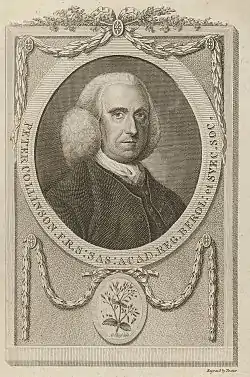1755 in paleontology
Paleontology or palaeontology is the study of prehistoric life forms on Earth through the examination of plant and animal fossils.[1] This includes the study of body fossils, tracks (ichnites), burrows, cast-off parts, fossilised feces (coprolites), palynomorphs and chemical residues. Because humans have encountered fossils for millennia, paleontology has a long history both before and after becoming formalized as a science. This article records significant discoveries and events related to paleontology that occurred or were published in the year 1755.
| |||
|---|---|---|---|
|
Fossils
- Joshua Platt, a dealer in curiosities, discovers three large dinosaurian vertebrae at Stonesfield. He sends them off for examination to a Quaker botanist, merchant, and friend of Benjamin Franklin named Peter Collinson. Sadly, Collinson never gives them Platt's desired examination, and the fate and specific identity of the fossils remain unknown.[2]
References
- Gini-Newman, Garfield; Graham, Elizabeth (2001). Echoes from the past: world history to the 16th century. Toronto: McGraw-Hill Ryerson Ltd. ISBN 9780070887398. OCLC 46769716.
- Farlow, James O.; M. K. Brett-Surmann (1999). The Complete Dinosaur. Bloomington, Indiana: Indiana University Press. p. 5. ISBN 0-253-21313-4.
This article is issued from Wikipedia. The text is licensed under Creative Commons - Attribution - Sharealike. Additional terms may apply for the media files.
